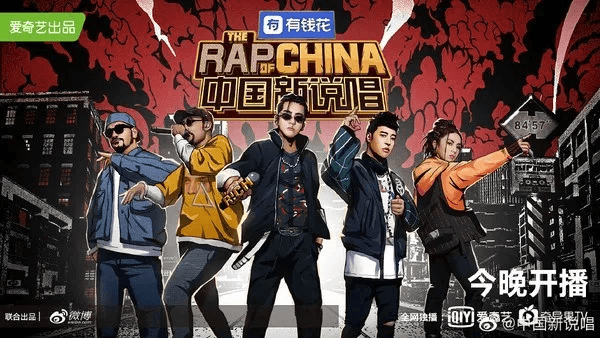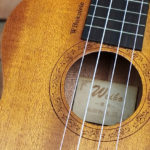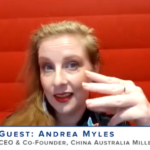Feeling the beats of the Chinese rap culture
Chinese rap and hip-hop music slowly emerged in the late 80s, along with the establishment of the Juliana Club in Beijing. In 1984, the club is the only one in Mainland China to welcome foreign DJs, who began to play rap on a daily basis. Chinese rap culture gives a space for Chinese subcultures to grow and thrive.
Rap music penetrates China under a western influence
The first rap singers in China spoke English because many believed that the Chinese language and its tones don’t fit the genre. One of the first Chinese DJs to rap at the time, DJ V-Nutz (Gary Wang), explained in 2007: “I would say that we don’t have a Chinese style yet. If you really want me to say, what is Chinese style, I would say it’s young. Local kids really enjoy western things right now. Then maybe after 10 or 15 years, maybe they can have their own style.” At that time, certain aspects of the hip-hop culture were making their ways onto Chinese billboards and charts, but not on the airwaves.

Source: VICE, Gary wang partying at ‘The Shelter’ a hip-hop club in a Beijing bomb shelter
The beginning of rap music in China
In 2003, the multinational Beijing hip-hop group Yin Ts’ang was the first mainland Chinese hip-hop group to release an album to critical acclaim. The group was made up of global nomads: two Americans, a Chinese Canadian, and a Beijinger. The diversity of the group – which is considered one of the pioneers of Chinese rap music – reflects Western influence in the beginning of China’s rap music.
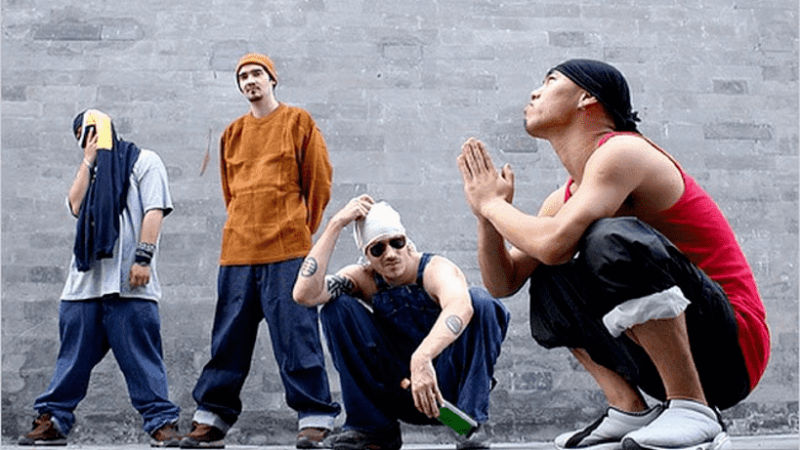
Source: The New York Times, The rap group Yin Ts’ang
Yin Ts’ang’s first hit was ‘In Beijing’ (Zai Beijing), from the group’s 2003 debut album, ‘Serve the People.’ The title melts a traditional melody played on the violin against a hip-hop beat. The song, whose Chinese lyrics explore the hidden corners and great deals of the Chinese capital, took the underground music scene by storm, eventually finding its way into karaoke rooms, the internet, and even the playlist of a radio station in Beijing.
The group defends its lyrics in Chinese, which awaken the Chinese urban youth. “Before that, kids listened to hip-hop in English, but maybe less than 1 percent could actually begin to understand”, said Zhong Cheng, a member of the Yin Ts’ang.
Rap music hits Sichuan
2006 saw the rise of another famous rap group from Chengdu called Big Zoo, with several mixtapes and freestyle releases. The group won several domestic awards before fading away in 2011. With its verses in Sichuan dialect, the group is commonly regarded as the one who led the development of the rap of Chengdu, and more importantly, the birth of a new urban subculture in Southwest China.
In the late 2000s, hip-hop venues are flourishing in China, and 2009 saw hip-hop being broadcasted for the first time by the China Central Television for the annual Chinese Lunar New Year Gala.
If the 2010s distinguishes China’s rap as a new genre of music, making Chinese rap at that time is still a profitless and often subversive activity. Thus, it is only in 2017 that Chinese hip-hop scene will burst with a dedicated TV program.
The reality TV show ‘The Rap of China’ has catalyzed the rise of hip-hop in China since 2017, exploring the new potential market to achieve monetization
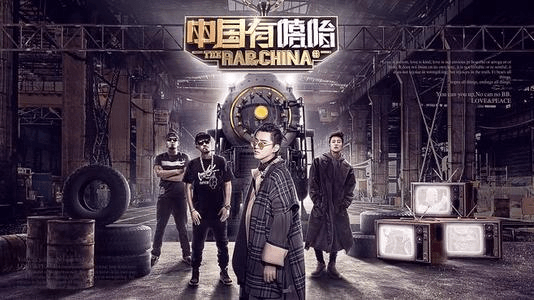
The underground and metallic decor of ‘The Rap of China’
“Do you have freestyle?” the sentence of Kris Wu, one of the judges of the TV show ‘The Rap of China’ (Zhongguo you xiha, or Zhongguo xin shuochang) went viral on Chinese social networks. The show consists of detecting new talents in Chinese rap, many of them previously underground, via a freestyle contest. Before the start of the 2019 season, the hashtag #TheRapOfChina reached 8.7 billion tags on Weibo across more than 44.23 million users discussing the show.
Through this TV show, iQYI (the Chinese video platform behind the show) explores the potential market of Chinese rap deeper by realizing the monetization of the rap industry. On top of Mainland China and Taiwan, the show is widely distributed to other Asian territories, bringing Chinese hip-hop culture to a broader audience. The show is such a hit among the young generation that it plays a big role in the trends of lifestyle and entertainment consumption in young people.
Since 2017, ten years after Gary Wang’s prediction about the future of the Chinese rappers, the buzzword ‘rap’ peaks according to the Chinese show’s episodes. Surprisingly, Chinese youth use the word ‘rap’ much more than its Chinese counterparts ‘嘻哈’ (xiha, meaning hip-hop) or 说唱 (shuochang meaning rap). The word ‘freestyle has no equivalent in Chinese, and many of the show’s participants mix Chinese and English in their verses.

Source: Baidu Index, the buzzword ‘rap’ peaks according to the Chinese show’s episodes
The Rap of China’s audience brings together Chinese Generation Z
Watching the program, the characteristics of Chinese rap immediately hit the viewer. The show is aimed at young Chinese urban culture, with an industrial and underground design, as illustrated in the image above. Chains, cans of paint, toolboxes, and other construction materials are part of the show’s decor, reflecting the rapid urbanization of China experienced by Chinese youth. The dark atmosphere immerses the viewer in the ambience of underground hip-hop clubs, often located in shelters and basements of major Chinese cities.
The audience brings together the Chinese generation post 95s and 00s. According to Baidu Index, around 70% of the Chinese people who search for ‘rap’ on the Chinese internet are under 30 years old. More surprisingly, females account for 55.8% of the total searches.

Source: Baidu index, daxue consulting analysis, age and gender distribution of rap fans in China
As for geographical distribution, rap consumers are mainly balanced between first- and second-tier cities, Beijing being the number one and Chongqing the 8th. The keen interest for rap among people from Chengdu city and the Sichuan province near Chongqing city is linked to the emergence of a new kind of rap, called ‘trap’ that shakes western China.

Data source: Baidu index, daxue consulting analysis Geographical distribution of rap fans in China
‘The Rap of China’ highlights Chinese-youth market potential
But what strikes the viewer at the very first glance is the ability of the show to be overcrowded with advertisement messages. The 2019’s season host the financial application 有钱花 (you qian hua, have money to spend) as the main sponsor of the show. The logo of the application appears everywhere, at the top of the show’s logo, at the bottom right corner, and in the decor of the show. The show even features promotional rap clips that highlight the brands’ products. Thus, marketing promotion is at the heart of the competition since participants must compete in promotional clips.
Brands sponsoring the most-watched show among Chinese youth reflect the market potential for brands targeting young Chinese. Thus, outside of the main sponsor, spirits brands such as Absolut Vodka and 江 小白 (Jiangxiaobai), a Baijiu brand from southwest China, are highlighted. A brand of shampoo, Clear by Unilever, appears regularly. Pepsi is also very visible during the show, as is War Horse 我马 (Wo Ma), a Thai Chinese energy drink brand. The American chewing gum brand, Extra, in Chinese 益 达 (Yi Da) and a brand of sanitary pads, are presented through rap clips during the show.

The brands sponsoring the 2019 season of ‘The Rap of China’ reflect the lifestyle of the new Chinese generation.
Rap as a route to gen-z marketing
With all these brands popping up during the show, one can wonder about Chinese young generation’s market potential. Gen Z, or the post-95 generation, includes nearly 170 million people in China. Even though many are not part of the workforce, it doesn’t keep them from spending money. Thus, 70% of them receive at least 3,000 yuan (USD420) in pocket money, while 21% are getting more than 10,000 yuan per month.
Moreover, according to Mckinsey’s China consumer report 2020, “young, free-spending consumers in lower-tier cities are today’s growth engine.” This critical set of consumers is unaffected by slowing growth and rising cost of living that affects top-tier cities in China.
In China, the target consumer does not just start at twenty-somethings with full-time jobs in the office. Many in their late-teens already have cash on hand even if they don’t have a fixed income. And advertisers on ‘The Rap of China’ know this.
Exploring Western China’s largest cities of rappers
As ‘The Rap of China’ displays, hip-hop music incorporates street fashion and internet culture, which is embraced, learned, and made by the young Chinese generation. The demographics analysis of the keyword ‘rap’ on Baidu display East provinces as the epicenter of the trend. However, in the west, we also see Sichuan province being hit by the phenomenon. A new hip-hop revolution called trap occurs in Chongqing and Chengdu, the two largest cities of the west. Trap music is a subgenre of hip-hop, characterized by the significant use of tuned kick drums and bass, and an often-dark ambience and lyrical content.
Meet Chengdu’s hottest rappers: Xie di, Higher brothers, Ty.
In Chengdu, Sichuan province, hip-hop is even hotter than its infamously spicy cuisine. Here lies the Higher Brothers, China’s hottest hip-hop export. This band of four friends is the first to make it internationally with their DIY lyrics, recording, and production. Their ‘Made in China’ clip on YouTube is the most viewed among Chinese hip-hop videos, almost hitting 20 million views.

Source: 88rising’s YouTube channel, Higher Brothers’ clip ‘Made in China’
Like Big Zoo’s former rap, they melt Sichuan dialect, Mandarin and English in their lyrics. But they never do it on purpose, mainly focusing on the meaning of the words in each of these languages, and how it sounds. If no one knows why trap takes off in Chengdu, the Sichuanese dialect could be the reason. This twangy local dialect is said to lend more naturally to the musical style than Mandarin, China’s official language.
The legendary Chengdu City Rap House is the heart of Chengdu’s rap. It’s one of the most influential hip-hop labels in China, best-known for nurturing the success of the Higher Brothers. The collective gathers other super-famous rappers from Chengdu, like Ty. and Boss Shady (Xie Di).
Chengdu’s rappers are up against strict censorship
The latter has known a burst of popularity in 2014 by bringing Chengdu’s rap to a Chinese talent TV show called ‘The Voice of China.’ In 2018, the rapper released a dialect-heavy track called ‘Fuck Off Foreigners’ (Gua laowai). The song’s harsh lyrics towards foreigners got him banned from performing in China for an entire year. But Shady is not letting censorship get him down, announcing its partnership with Ty. to build a new record label.
Ty., Chengdu’s most successful solo rapper domestically, also experienced the throes of censorship through his breakout track ‘Hooked on drugs’ (Hai yao shang le yin), in 2014. The rapper appears then in ‘The Rap of China’ with a more commercial-friendly rap featuring other artists, including Boss Shady. A longtime friend of the Higher Brothers, he is also featured in some of their newly released tracks.
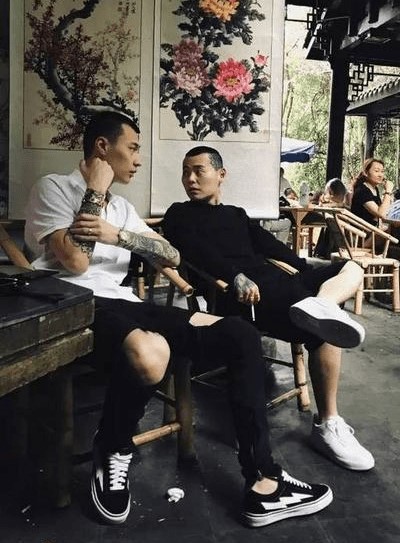
Source: VICE, YouTube, Ty. (left) and Boss Shady (right)
But a new unpleasant rivalry is coming from another neighboring western city, whose rappers have built their popularity on the back of the success of ‘The Rap of China.’
Chongqing, the Atlanta of China
This city is Chongqing, China’s third-largest city, and home to 31 million people. The commonly nicknamed ‘fog city’ or ‘bridge city’ is often compared to Atlanta, Georgia the birthplace of trap music in the United States.
Here lies the GOSH music label, gathering the most influential rappers of Chongqing, with well-known names across China, such as GAI, Bridge, and Wudu Montana. These three rappers all appear in the wildly popular reality show ‘The Rap of China’, with GAI winning the first season, in 2017.
However, GAI’s first burst of popularity came in 2015, along with the release of ‘Gangster,’ a controversial track in which the rapper claims to be a gangster. The track has soon been banned on the multiple Chinese video websites, people questioning the fact that this song could instigate criminal activities.
How a matcha-shop-owner-gone-rapper popularized Chongqing’s rap music
Popularizing rap using Chongqing dialect with similar dialects, GOSH label is maximizing its influence over the southwest region. The first rapper to sing about the fog city is Wudu Montana (Wudu literally meaning ‘fog city’ in Chinese), a matcha tea shop owner. Just like the Yin Ts’ang crew, his first hits told about his daily life growing up in the vast city, and its development since the 90’s. It is this street culture that he tries to transmit in his sounds. According to him, “Chongqing has changed a lot, things that were once small are now big.”
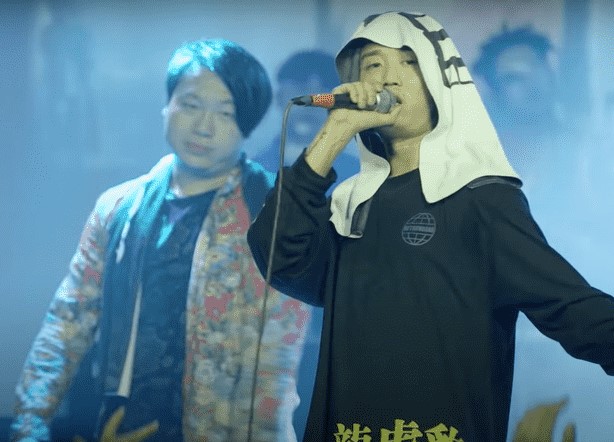
Source: VICE, YouTube, Wudu Montana (left) and Gai (right) on stage
Another rapper, whose name also resonates with the city and its many bridges, has recently become the Chongqing’s new rising star. Bridge is perhaps Chongqing’s rapper whose look is the most explosive. Dreadlocks and large bubble glasses are the hallmarks of this energetic rapper. According to him, trap allows people to express things with beats, just like the Chinese poets did in the old days.

Bridge during his participation for the season 2 of ‘The Rap of China’
Chongqing’s rap is more aggressive than Chengdu’s. This is reflected in what those rapper call ‘attitude.’ If people tend to compare Chengdu and Chongqing’s rap, we see that these rappers have their own shining characteristics, whether they come from Chongqing or Sichuan.
Chinese rap is going outside of China
That being said about ‘The Rap of China,’ Chengdu, and Chongqing’s rap, we are obviously currently witnessing the rise of the Chinese rap music. But what about globally? Is there any opportunity for Chinese rap to catch foreign audiences, while foreign streaming music and video platforms are blocked in China?
88rising, a multimedia company and music label for Asian rap in the US
A New-York based company launch in 2015 made its top priority to raise the profile of Asian hip-hop in the United States. Its name is 88rising (the 8 is the luckiest number in the Chinese culture), an Asian-focused record label and media company. The company, which only features 3 to 4 Asian artists at a time, focus on exporting Eastern culture to the West, one viral hit at a time. Among the featured artists, the Higher Brothers’ crew represents the Chinese branch.
Since the Higher Brothers signed in 2016 under 88rising’s banner, the Chengdu’s rap group completed two US tours in front of sold-out crowds. The first move of 88rising to translate the Higher Brothers hype in the United States came with the viral YouTube video ‘Rappers React to Higher Brothers’, where famous US rap artists reacted very positively to their ‘Made in China’ hit. Since then, the crew released its long-awaited new album, ‘Five Stars’ still under the 88rising label.
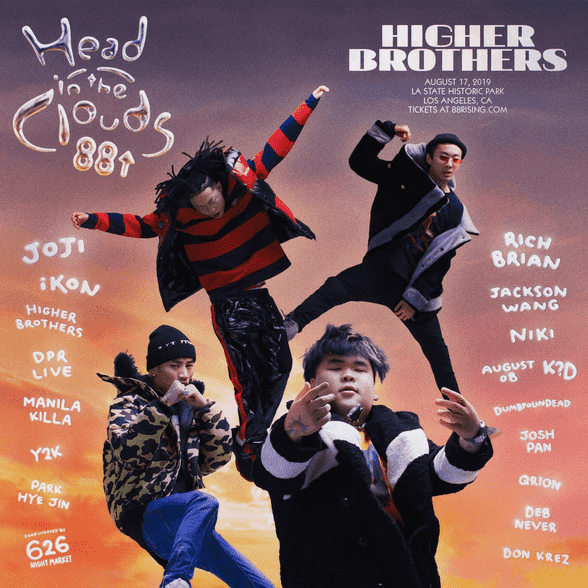
Source: Higher Brother’s Facebook page announcing their participation at 88rising’s music festival in Los Angeles, 2019
Much of the power of 88rising is due to the fact that it operates more like a PR agency than a record label. Miyashiro, 88rising’s CEO, estimates that only 30% of the company is dedicated to full-time music. In comparison, the other 70% is split between video production, business development, and fostering direct relationships with streaming music and video platforms, their digital playground.
But in China, relationship with Spotify’s teams are not enough, with most foreign streaming platforms blocked and replaced by local equivalent. This explains why 88rising decided to break the Chinese walls by employing a dozen full-time staff in Shanghai.
In 2019, Higher Brothers won the award for hip-hop artist NetEase’s label of the years, 88rising taking the award for Chinese music streaming of the year at the same event.
Could censorship be the glass ceiling of the rise of China’s rap music?
Ironically, one month after receiving these awards, several 88rising tracks were pulled from NetEase, ostensibly for lyrical content failing outside the requirements of Chinese censors. Even the wildly popular reality show ‘The Rap of China’ fall under the state broadcast administration regulations, which prohibited depictions of the hip-hop culture, including tattoos and obscene lyrics. Making rap about drugs, sex, violence, and politics is out of the question.
The beginnings of hip-hop – including trap music – in China were primarily influenced by western culture. Western lyrics often include violence and anti-system verses, a path that Chinese rappers tried at their expense.
Even with censorship, however, the success of rap in China among the young Chinese generation is real. By moving west towards Chengdu, Chinese rap has only proven its uniqueness: it is incisive, technical, and requires great dexterity to mix Chinese dialects, Mandarin, and English. It focuses on the style and character of the rapper, verses from Chinese rappers appearing in the process of building a full-fledged character, with coolness and attitude at its center.
Author: Maxime Bennehard
Also read, what Chinese say about the black lives matter movement
Listen to 100 China entrepreneur stories on China Paradigms, the China business podcast
Listen to China Paradigm on Apple Podcast



